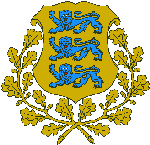

Estonia
Written and Researched by Margaret Sypniewska, B.F.A.

The name Estonia is thought to have come from a tribe called the Aestii. The Aestii gathered amber, worshipped the mother of gods, and took as her emblem the boar.
The area called Estonia has not changed much in the last 1500 years. Twenty-first century Estonia is about the size of the United States of America states of Vermont and New Hampshire combined. Estonia is larger than Denmark, Switzerland, the Netherlands, and Belgium. Estonia borders, on the west and north with the Baltic Sea and the Gulf of Finland. This location affords trade with both Europe and Scandinavia. Other nations on the Baltic are Germany, Sweden, Poland, and Denmark. In fact, these same countries have at one time or another invaded Estonia.
Estonia is part of the great East European plain. Estonia is divided into two regions:
1. Lower Estonia - which includes the western and northern coastal regions, the islands, and lakes around Peipsi and Vorts (the two largest inland waters).
2. Upper Estonia - includes the central and southern regions, the lake districts, including Rakvere (Wesenburg), Paide (Weissenstein), Vijandi (Fellin), Tartu (Dorpat) and Voru (Werro).
Ninety (90) per cent of Estonia is less than 100 meters above sea level. The highest point in Estonia is Suur Minamagi which reaches 318 meters. Lower Estonia is flat and marshy. Upper Estonia has varied landscapes and is more agriculturally fertile. Estonia has no major natural resources. The only mineral wealth is oil shale and phosphorite, limestone, and dolomite.
Estonias climate is continental with the effects of the Baltic Sea and Gulf Stream tempering it in the winter.
The Estonian language belongs to the Uralic or Finno-Ugric linguistic group. Hungarian, Finnish, and Estonian scholars agree that the homeland of the Finno-Ugrians is found in the forest zone of Eastern Europe, west of the Ural mountains. The Hungarian linguist, Peter Hajdu, thinks the Uralic homeland was on the eastern side of the Ural mountains from 6,000-4,000 B.C. He also thinks they traveled west around 3,000 B.C.
Iron was imported to the Baltic region, and somewhere around the birth of Christ, iron replaced stone as the material of choice for weapons and tools. Barley was the major crop at the time of Jesus. Wheat was cultivated, but rye was the staple of life. Today this is not the same.
Estonia was a popular Viking trade route on the way through Russia to Byzantium in the ninth (9th) and tenth (10th) centuries. They imported iron, copper, bronze, precious metals, and finished products. Exports were bearskins, wax, grain, and cattle. By the twelfth century Estonians were not on the trade route, so they pursued active trading and plundering policies to the west using the Baltic Sea as their route. Estonia still traded with Novgorod however.
SOURCES:
This page was last updated on May 6, 2007
